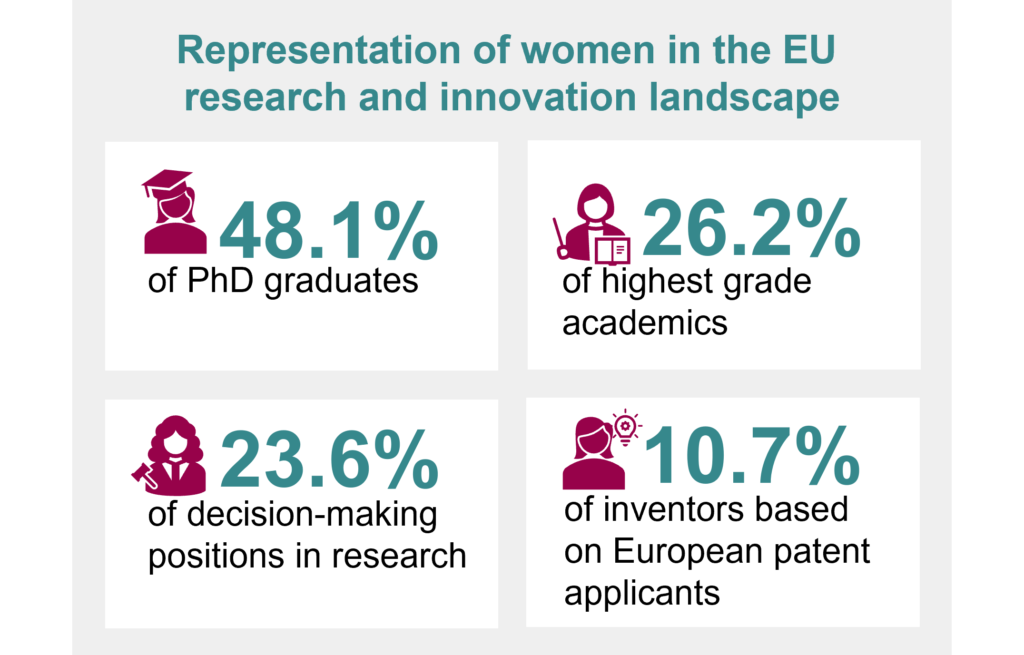A gender lens for EU research on International Women’s Day 2022
8th March 2022 at 3:19 pm
Today, we celebrate the 111th International Women’s Day. Today, the aim to achieve gender equality is still ongoing across most sectors of society and it has found a further challenge in the effects of the COVID-19 pandemic. Indeed, a series of events organized by the European Parliament around this 8 March focus on the exacerbated inequalities brought by the pandemic. While the data in support of what has been defined as the ‘she-cession’ that we’ve been part of and witnessing during the last couple of years is still slowly trickling in, we here give space to some of the latest data on gender (in)equality in research.
What does gender in research look like in the European landscape?
In November 2021 the European Commission published the She Figures 2021 report. Released every three years, the She Figures report presents comparable, pan-European data on gender equality in research and innovation. Including data and analysis of 88 indicators, it examines gender across research disciplines, career levels and occupational sectors, as well as in terms of working conditions, funding opportunities and research and innovation output. Most of the data presented in the 2021 edition are for the year 2019 and while they present positive trends towards equality for a few indicators, such as the share of women among PhD graduates, it shows that much still needs to be done to achieve gender equality in research, at least in the EU. From the more than 350 pages report, we share with you below a few highlights, which help paint a first picture of the current situation for women in research in Europe. In considering the data below, mind the fact that these values are taken as a European average (EU-27, i.e., the UK is not included) and there is variability across countries. If you are curious to see how your country is doing, go straight to the source: in the She Figures 2021 you will find all data for all European countries. But now, let’s finally put this black on white.

While at the graduate level there is almost gender parity, with women accounting for 48.1% of PhD graduates, they account for 42.3% of academic staff, 26.2% of those in the highest-grade positions and only 23.6% of those in decision-making positions in research. Broadening the focus a bit and looking also at self-employed professionals in technical fields, we see that women account for 24.9% of these. The scenario is more worrisome considering the innovation output, as based on European patent applications a mere 10.7% of inventors are women. There are also generally more men than women active authors, when looking at peer-reviewed publication outputs and, closely related to this, men seem to keep a slight advantage also in their success in acquiring research and innovation funding. If you’re familiar with the EU Framework Programme for research and innovation (Horizon 2020 and now Horizon Europe), you may wish to check out the Horizon Dashboard for H2020 Cross-cutting Issues I, where you’ll see that women accounted for 41.2% of participants but only 22.9% of coordinators in H2020 projects.
There is still much to be done…
While this offers just a small glimpse into the gender underrepresentation seen in research and innovation, it is clear that still plenty needs to be done to achieve gender parity. As we hinted to in a previous blog post, early data already showed in 2020 that the COVID-19 pandemic is further exacerbating the gender gap. That’s the case in the research environment, but not only. Thus, even more so now, we should take care to look at research and society through a gender lens. In the occasion of last year’s International Women’s Day we already summarized how the European Commission has integrated its priority towards gender equality in science, research and innovation through a series of requirements and measures implemented across Horizon Europe. The requirement of integrating the gender dimension in research proposals and projects is especially needed and will hopefully lead to a much more positive outcome in comparison to the mere 1.7% of projects that included a gender dimension during H2020.
…we can start by asking “why?”
But, why are we sharing this data with you today? Alongside celebrating the many wonderful women in our lives and at the heart of our society and showcasing some of the many examples of women researchers, being aware and understanding the gender inequality issues embedded in our society is a first step, and one that we can all start to take, towards tackling it. Faced with the data, one can perhaps consider asking “why?”, why is there such disparity between women and men in research today. Part of the answer, perhaps leading to some additional pondering, lies in the concept of unconscious or implicit bias. Do you have biases? Treat yourself to 5 minutes of self-exploration today and find out if you have any biases associated to gender in science by completing the Implicit Association Test (IAT) for gender–science developed by researchers at the University of Washington, University of Virginia, Harvard University, and Yale University. You might be surprised.
Would you like to know more?
If you are curious to learn more about gender in research, we have compiled a selection of references and resources for you below. If you have read this far, thank you for taking your time today to read and think about the importance of gender equality. Happy International Women’s Day!

Denise Diggelmann
Marketing and Communications Associate
References and resources
- The term ‘she-cession’ was coined by Dr. C. Nicole Manson, President and Chief Executive of the Institute for Women’s Policy Research. See Alisha Haridassani Gupta’s article “Why Some Women Call This Recession a ‘Shecession’”: https://www.nytimes.com/2020/05/09/us/unemployment-coronavirus-women.html
- Dolan, K. and Lawless, J.L., It Takes a Submission: Gendered Patterns in the Pages of AJPS. AJPS Editor Blog, 2020, https://ajps.org/2020/04/20/it-takes-a-submission-gendered-patterns-in-the-pages-of-ajps/
- European Commission, Directorate-General for Research and Innovation, She figures 2021 : gender in research and innovation : statistics and indicators, Publications Office, 2021, https://data.europa.eu/doi/10.2777/06090
- European Commission, Directorate-General for Research and Innovation, Gendered innovations 2 : how inclusive analysis contributes to research and innovation : policy review, Publications Office, 2020, https://data.europa.eu/doi/10.2777/53572
- European Institute for Gender Equality (EIGE) COVID-19 and gender inequality resources page: https://eige.europa.eu/topics/health/covid-19-and-gender-equality
- Minello, A., The pandemic and the female academic. Nature, 2020, doi: 10.1038/d41586-020-01135-9
- Reichelt, M., Makovi, K., Sargsyan, A., The impact of COVID-19 on gender inequality in the labor market and gender-role attitudes, European Societies, 23:sup1, S228-S245, 2021, doi: 10.1080/14616696.2020.1823010
- Wenham, C., Smith, J., Morgan, R., COVID-19: the gendered impacts of the outbreak. The Lancet, 395 (10227), 846-848, 2020, doi: https://doi.org/10.1016/S0140-6736(20)30526-2
- European Commission, Cordis, Gender in research: Tackling inequalities for an inclusive European research area, Cordis Article, 2022, https://cordis.europa.eu/article/id/435706-gender-in-research-tackling-inequalities-for-an-inclusive-european-research-area
